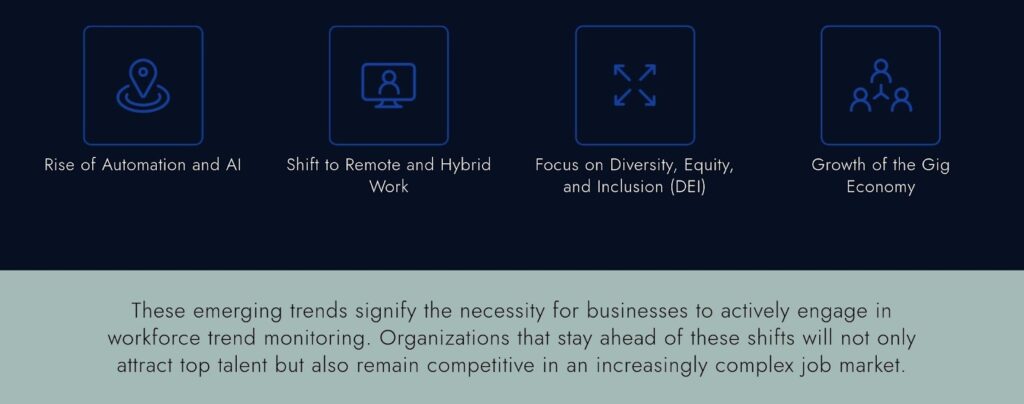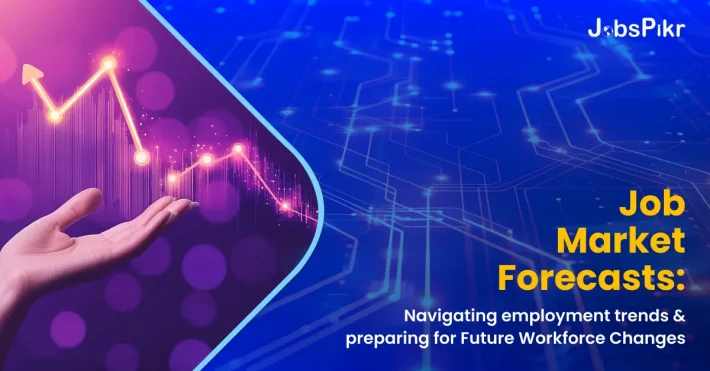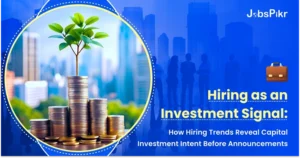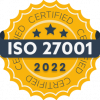The modern job market is in a constant state of evolution, driven by rapid technological advancements, demographic shifts, and changing organizational priorities. For market research firms and businesses alike, understanding employment trends and future workforce changes is crucial to maintain a competitive edge. In this article, we will explore how job market forecasts provide valuable insights into emerging workforce trends and help organizations navigate these changes efficiently. By anticipating these shifts, companies can enhance operational efficiency, ensure a strong talent pipeline, and prepare for long-term success.
Why do Employment Trends Matter for Workforce Planning?

The dynamics of the workforce have seen significant changes in recent years. From the rise of automation and artificial intelligence (AI) to the shift toward remote and hybrid work models, employment trends are constantly reshaping the way businesses operate. For organizations, monitoring employment trends is not just a reactive strategy; it’s a proactive approach that allows businesses to prepare for future disruptions.
According to a recent job market forecast, some key trends are already influencing the future workforce, including:
- The Integration of AI and Automation: Machines are increasingly performing tasks once carried out by humans, prompting a need for reskilling and upskilling in various industries.
- Remote and Hybrid Work Models: The COVID-19 pandemic accelerated the shift towards remote work, a trend that is expected to stay in many sectors.
- Diversity, Equity, and Inclusion (DEI): Companies are becoming more inclusive, recognizing the importance of diverse teams in fostering innovation and improving decision-making processes.
- Gig Economy Growth: More workers are engaging in freelance or gig work, leading to significant changes in how companies hire and retain talent.
These emerging trends signify the necessity for businesses to actively engage in workforce trend monitoring. Organizations that stay ahead of these shifts will not only attract top talent but also remain competitive in an increasingly complex job market.
How to Leverage Job Market Forecasts for Strategic Decision Making?

A job market forecast provides a roadmap for organizations, helping them understand where the employment landscape is headed. By leveraging data-driven insights, businesses can plan their talent strategies to align with future trends. For example, a forecast may reveal the industries where job demand is expected to grow or highlight emerging skills that will be in high demand.
Market research firms, in particular, can play a critical role in helping businesses interpret and act on these insights. Through comprehensive research and analysis, they provide valuable context on how changes in the job market now will impact long-term talent strategies.
Some actionable steps that organizations can take based on job market forecasts include:
- Skill Gap Analysis: Businesses should assess current and future skill needs to identify any gaps. This allows them to implement training programs or recruitment strategies to address those gaps.
- Talent Acquisition Strategy: With an understanding of emerging employment trendscompanies can adjust their recruitment strategies to focus on high-demand skill sets. For instance, a job market forecast may indicate the growing need for data scientists, prompting organizations to prioritize this talent in their hiring plans.
- Workforce Flexibility: Forecasts often reveal how work models are evolving. Companies that adapt by offering flexible work arrangements, such as hybrid or fully remote roles, can better attract and retain top talent.
- Investment in Technology: As technology continues to play a more significant role in the workplace, organizations should invest in tools and systems that improve productivity and enhance employee engagement.
By utilizing a job market forecast, businesses can transform workforce planning from a reactive process into a forward-thinking strategy that promotes long-term growth.
How Job Market Forecasts Help Navigate Workforce Changes?
The primary benefit of workforce trend monitoring is its ability to guide organizations through changes in the job market. Rather than being blindsided by new trends or disruptions, companies that keep an eye on the latest developments are able to anticipate and prepare for these changes. This gives them a significant advantage in terms of both hiring and operational efficiency.
Here’s how employment trends are likely to shape the future workforce:
- Adoption of Digital Skills:
With the rise of AI and automation, digital skills are becoming more important across industries. According to recent job market forecasts, sectors such as technology, healthcare, and finance are likely to see the highest demand for workers skilled in data analysis, programming, and cybersecurity.
- Reskilling and Upskilling Initiatives:
The rapid pace of technological change means that employees must continuously develop new skills to remain competitive. Companies that prioritize reskilling and upskilling initiatives will be better positioned to meet future workforce demands.
- Workforce Diversity and Inclusion:
Diversity is not just a social priority, but also a business imperative. Studies show that diverse teams are more innovative and perform better financially. As such, organizations will need to build inclusive talent pipelines that reflect the diverse global workforce.
- Gig Economy and Freelance Work:
The traditional 9-to-5 job model is evolving, with more professionals opting for freelance or gig work. This trend is reshaping how companies source talent and manage their workforce, as they increasingly rely on a blend of full-time employees and independent contractors.
- Work-Life Balance and Employee Well-being:
Employees are placing greater emphasis on work-life balance, mental health, and overall well-being. Organizations that recognize these priorities will not only improve employee retention but also attract top talent in a competitive job market.
These insights show that workforce trend monitoring isn’t just about identifying changes in the labor market—it’s about using this information to create a more agile, flexible, and future-ready organization.
Future Workforce Changes: How to Adapt to Future Workforce Trends?
The key to successfully navigating the future workforce lies in an organization’s ability to be adaptable. This adaptability stems from understanding employment trends and the potential changes on the horizon, as revealed through a job market forecast. For businesses, adapting to these trends requires a combination of strategic foresight, investment in talent development, and a commitment to innovation.
To adapt effectively to future workforce changes, organizations should consider the following strategies:
- Continuous Learning Culture:
Encourage employees to pursue continuous learning and development. This can be facilitated through online courses, workshops, and mentorship programs. By fostering a culture of learning, businesses can ensure their workforce remains adaptable to new challenges.
- Flexible Work Arrangements:
As remote work continues to gain popularity, businesses must offer flexible work options to attract top talent. This may include a combination of in-office, remote, and hybrid work models to meet the diverse needs of employees.
- Talent Pipeline Development:
Building a strong talent pipeline is critical for long-term success. Organizations should focus on developing internal talent, as well as partnering with educational institutions to tap into emerging talent pools.
- Diversity and Inclusion Initiatives:
To remain competitive in the global marketplace, organizations must prioritize diversity and inclusion. This involves creating a workplace culture where employees from all backgrounds feel valued and supported.
- Technology Investment:
Future workforce changes will be driven by technology. Businesses that invest in cutting-edge tools and platforms will be better positioned to enhance productivity, improve collaboration, and maintain operational efficiency.
By following these strategies, organizations can ensure they are well-prepared to face future workforce changes and continue thriving in a dynamic job market.
Conclusion
In today’s rapidly evolving business landscape, understanding employment trends and job market forecasts is critical for any organization looking to stay competitive and future-proof its workforce. By closely monitoring workforce trends, businesses can anticipate changes, adjust their talent strategies, and navigate the complexities of the modern job market with confidence.
For market research firms, this insight into workforce dynamics offers an invaluable opportunity to guide their clients through future challenges. By leveraging comprehensive job market forecasts, they can help organizations not only survive but thrive in the face of workforce transformation. Businesses that embrace this forward-thinking approach will be better equipped to secure a sustainable, high-performing workforce, ensuring long-term success and operational efficiency.
To gain real-time job market data and actionable insights into employment trends, Sign up on Jobspikr—an advanced solution designed to provide companies with critical workforce intelligence, helping them stay ahead of the curve and navigate future changes with confidence.




